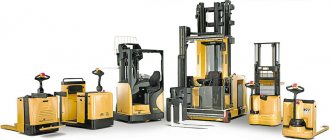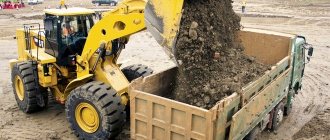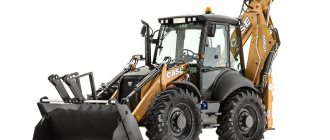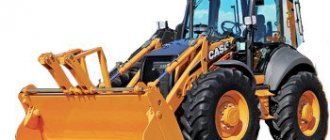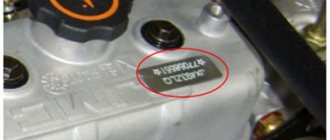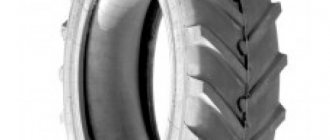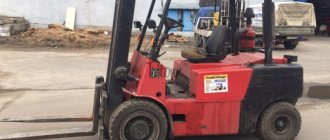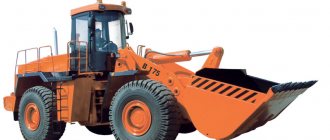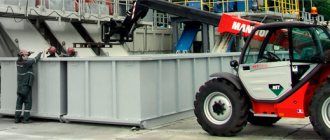- Stacker: Definition and Origin
- Reach truck: definition and origin
- Design differences
- Differences in lift height
- Types of reach trucks and stackers by type of workplace
- Requirements for free space for work
- Difficult to manage and maintain
- Productivity and accuracy
- Cost and comparison results
The purposes of using reach trucks and self-propelled stackers are very similar. Both types of warehouse equipment are designed for transporting and stacking palletized goods on racks in limited space. However, stackers and reach trucks differ from each other in the following points:
- design;
- lifting height (not always);
- requirement for a free space for work;
- complexity of management and maintenance;
- productivity and accuracy of work;
- cost.
Stacker: Definition and Origin
A self-propelled electric stacker is an electric trolley equipped with a mast and lifting forks. Unlike a forklift, it is poorly suited for transporting goods, since its main task is to stack palletized goods on top of each other or on rack shelves. Thanks to its compact size, it is well suited for working in the aisles between racks or stacks.
Historical reference:
The first warehouse stacker appeared back in 1926. It was developed by the French company Fenwick, who called it a "lifting platform trolley" (Image 1). It was intended for loading goods onto trucks, trains and placing goods on warehouse racks.
Image 1: The first warehouse stacker produced by the French company Fenwick
Maneuvering in narrow passages
The most difficult maneuver when operating a reach truck is when picking goods from the rack. To do this you need:
- drive into the aisle with the forklift fully retracted;
- turn 90 degrees so that the forks are in the correct position opposite the desired section of the rack;
- Raise the forks to the required level and then push them outwards until they fit into the pallet.
- lift the load and remove it from the rack, pulling the forks back towards the reach truck;
- lower the load and turn back 90 degrees to exit the aisle.
Experienced operators can immediately pick up pallets with their forks fully extended, but this requires years of practice.
Reach truck: definition and origin
From a technical point of view, a reach truck is a stacker with a retractable load lifter . Either the mast itself or the fork can extend. This type of warehouse equipment is specially designed to work in narrow aisles (NA - narrow aisle) with a width of 1.6 m, and is recommended for warehouses with a storage height of goods up to 12 m. The use of reach trucks makes it possible to increase the storage density of goods by one third or more ( depending on the height and type of racking systems).
Interesting to know: The word “reach” (from the English reach) in the name of the car speaks of its ability to “reach” beyond the wheelbase.
Historical reference:
The invention of reach trucks was led by the need to increase the storage density of goods, since in the 50s of the last century there was an acute shortage of warehouse space in the United States. The first mass-produced reach truck was developed in 1951 by the Raymond Corporation and appeared on the North American warehouse equipment market in 1954. It is based on a stacker with widely spaced support arms and features a patented pantograph mechanism to extend the forklift (Image 2).
Image 2: Raymond Corporation's first Richtak (left) and its modern descendant (right)
Results of comparison and conclusions for tasks
In practice, both types of warehouse equipment are actively used. In small warehouses with a small volume of work, you can buy a stacker, and if the acceptance and shipment of goods is active, and the pallets themselves are at a high height, then you cannot do without a reach truck. The price for them will differ by 1.5-2 times, but due to greater productivity this difference is leveled out quite quickly. You can select suitable equipment for working in a warehouse, lifting cargo, rigging work in our company by contacting phone number 8 or sending a request to
Design differences
The key difference lies in the design of the lifting mechanism. For stackers, the mast is stationary and the carriage with forks can only move up or down along it (Image 3). Therefore, moving the load horizontally always requires movement on the floor.
Image 3 – The degree of freedom of the stacker forks is limited to vertical movement
The main design feature of the reach truck is its retractable mast, which helps stabilize the load and provides greater maneuverability in tight spaces.
| Unlike a stacker, the mast of a standing reach truck can be extended. |
Image 4: Reach truck with retractable mast
Formula 12: how to drive a reach truck
Since Michael Schumacher left the big races, the issues of speed and control of advanced technology have disappeared from the agenda. Well, really! First, we reduce the engine capacity of the cars, put the pilots on a diet, discuss whether the girls should go out onto the grid with flags, and then ask: “Where are the spectators?” We're out! Everyone left to see how to drive a reach truck.
The Finns start and win
Why are Finnish pilots the best in the world, if we count the Germans on the jury? Kimi Raikkonen, who in between the parties managed to grab the title of world champion, and then twice Hero of Socialist Labor vice-champion, and then three times bronze medalist, once said:
I read somewhere that I manage to travel only thanks to the luck that accompanies a drunkard.
What deep meaning is hidden in this phrase. No, we do not promote Kimi’s lifestyle, but we wholeheartedly promote the image of the cars he piloted. Just imagine how smart the technology must be to bring Kimi Raikkonen not only to the pit stop and to the finish line, but also to the championship!
The article about the rules for managing warehouse equipment does not detract from the importance of other transport, but it shows how close our life came to the ideal when forklifts appeared in it.
Let's think about how many global automakers we know about:
- Mercedes (Germany).
- BMW (Germany).
- Toyota Motor (Japan).
- General Motors (USA).
- Renault–Nissan–Mitsubishi Alliance (We don’t know what, God forgive me!).
Where are the Finns? There is only one explanation - the whole nation is mobilized to improve and produce reach trucks, otherwise, where does such success come from?
Reach truck, aka loader, aka stacker
Since in Finland, unlike its southern neighbor, mineral reserves are scarce, and the population’s needs, on the contrary, are for wagons, warehouse equipment is designed to be multifunctional. If you decide to buy a reach truck , you will receive not just a loader on wheels, but a device with a wealth of capabilities, including:
- Loading and unloading.
- Moving around the warehouse.
- Lifting and lowering loads from high racks.
- Movement along narrow passages.
Of course, the enemy’s fly in the ointment crept into the ointment. There is one significant drawback - the reach truck does not prepare coffee and does not bring a fragrant drink to bed, otherwise there is nothing to complain about.
A skeptic's question: if you have a weakling, why pay for a reach truck?
When deciding to buy a reach truck, the price can say a resounding no to the warehouse owner. And this is correct if you have a storage area of 200 m2 at your disposal, which you can manage on your own. On two or more thousand m2, another strategy is applicable: put aside prejudices and believe that everything will work out by itself.
Such a cunning scheme, according to probability theory, is suitable for less than 1% of cases; for the remaining 99%, there is only one way left - to modernize the warehouse and still buy a used or new reach truck - that’s how it turns out.
Let's step on the gas!
Warehouse equipment neither in front nor in profile looks like Formula 1 cars. But let's compare the possibilities:
| Comparison | F1 car | Reach truck |
| Whom does it carry?? | Superpilots with salaries starting from $1 million. | Anyone who can tell a control panel from a rabbit. |
| What it does? | Nothing. | Organizes cargo so that the warehouse does not turn into a landfill. |
| How does work affect savings? | Have you fallen from the moon? Here the opposite task is to throw money down the drain. | Even if a rabbit is driving, the savings will be at least 40%. |
Can an F1 car carry at least 500 kg? Of course not! Pilot Jenson Button in his best years was emaciated so that he would lose 2.5 kg. No, the world champion was driving the wrong vehicle! The most ordinary reach truck lifts from 1,000 kg to 2,500 kg without appealing to Bernie Ecclestone and other elders who went crazy back in the 20th century.
Let's move on to management (we got distracted)
So, none of the luminaries of theoretical physics studied driving reach trucks in reverse. And the Finns studied and realized that in a warehouse it is not enough to move only forward with a load; it is also necessary to ensure maneuverability and the ability to perform work in reverse.
The problem is that the main operation is not to ride back and forth, but to use the forks every time, removing and installing useful and not so useful loads on the racks.
Everyone is ready to maneuver!
Operating the equipment is not difficult, but you still need to be sure of the most important thing - removing the pallet from the rack. For those users whose experience is zero or has gone into negative numbers (and this happens if you turn a load), we offer a small cheat sheet:
- You must enter the passage with the telescopic mechanism fully assembled.
- Stand on a point and turn 90 degrees, taking the azimuth to the desired section.
- Raise the forks to the desired level, then carefully aim and push them forward, trying to get under the pallet.
- Raise the load a couple of tens of centimeters, remove the pallet from the rack, smoothly retracting the forks.
- Lower the load to the floor, turn 90 degrees in the same direction from which you entered, and leave with a feeling of accomplishment.
We know that experienced operators don’t do this. They immediately grab the pallet with outstretched forks. This kind of dexterity comes after many years of practice, so don’t go for showmanship (this is fraught with consequences), focus on efficiency.
Pedals and other controls
In order for the equipment to move, the operator just needs to press the pedal. When released, the loader stops. Nothing complicated! Advanced models offer automatic fork leveling, wheel sensors, side shifters and other options to improve accuracy.
We will not skip past a word that is not clear to everyone, but will linger on it longer.
Sideshifters (from the English Side Shift, but some prefer to leave the abbreviation SS) are additional equipment responsible for shifting the carriage in the lateral directions by 100–160 mm. Thanks to the device, loads can be moved both forward and backward and left and right. This is especially convenient in narrow aisles.
Conventional reach trucks have fork control levers, which include separate handles for lifting and lowering, side shift and tilt. You can order equipment with a joystick, which, you see, is much more convenient.
What Finnish engineers did not take into account
Of course, the Rocla company employs smart guys of seven or even eight spans in the forehead, but even they, who closely monitor the needs of their southern neighbor, failed to take into account all the needs, nuances and features that should be in technology.
Let's think together what first comes to mind when looking at domestic roads. Let’s immediately take obscene language out of the equation - we’re not like that! - and let’s leave the ubiquitous holes that have not disappeared for centuries, before overcoming which the most impressive ground clearances give in. The Finns, frankly, missed this detail.
The small clearance of reach trucks gives better stability, but leaves no chance for a crooked floor. However, this is good, otherwise desperate daredevils would try to work at heights, balancing with a load of a couple of tons on potholes and potholes.
To paraphrase the classics, let's say: a reach truck is not a luxury, but a means of moving and organizing cargo in warehouses whose owners care about their profits.
Differences in lift height
Due to the design features, the maximum lifting height of forks on stackers is in the range of 1.6–6 m. Reach trucks, on the other hand, are capable of lifting loads up to 2 times higher: usually their “ceiling” reaches 3–12 m (Image 5). This outstanding ability is due to the fact that they are usually equipped with options that promote better balance support and load control:
- tilting the mast and forks;
- movable carriage;
- counterweight or cabin;
- video monitoring system.
Image 5: Stackers generally have lower lifting heights than reach trucks
Operational Features
Each operator working on a reach truck must have a special category of rights to operate professional lifting equipment and during operation he must remember the residual lifting capacity of the device at maximum height.
When choosing a suitable model of warehouse equipment, you need to pay attention to the following parameters:
- maximum weight;
- ability to perform work at heights;
- cargo dimensions for the platform;
- speed control indicators.
During the operation of lifting equipment, the operator must carry out maintenance required by the manufacturer’s regulations. Particular attention is paid to such components as the battery, supporting structural elements, wheels and technical indicators of fuses. At the first signs of wear, it is necessary to replace spare parts. The reach truck can be used in small warehouses with a flat floor and no visible obstacles. Only trained operators are allowed to operate the equipment.
Types of reach trucks and stackers by type of workplace
Both types of equipment can be driven, with a platform or with an operator’s cabin. However, among stackers, driven or driven models predominate, which are controlled from the floor using a long handle. Most reach truck models, on the contrary, are equipped with cabins for a standing or seated driver.
The appropriate type of equipment is selected depending on the size of the warehouse and the intensity of work (Table 1).
| Stacker/reach truck type | Max. travel speed, km/h | Max. lifting height, m | Recommended travel range, m | Duration of operator work, h |
| Slave (lead) | 3–5 | 1,6–3,5 | 20 | up to 2 |
| With platform | 4,5–6 | 1,6–4,5 | 50 | |
| With cabin, standing | 5–10 | up to 6 (stacker) up to 12 (reach truck) | 100 | 2–5 |
| With cabin, sitting | 10–20 | 5–8 |
Table 1: Machine types and characteristics
What is the device
The design is one of the types of stackers, but with more convenient technical characteristics. The main difference lies in the presence of a retractable mast. It is with its help that special equipment can be used at considerable heights. Today, not a single large warehouse can operate without racking systems located at a large elevation from the floor, which means purchasing a mechanism becomes an important investment in logistics.
Despite its complexity, the dimensions of a reach truck are significantly smaller than those of simpler models of loaders, which means they can be used even in particularly narrow passages. This factor does not reduce the carrying capacity. It is up to 2.5 tons for different models. In simple words, the mechanism can be called a successful hybrid of a classic stacker and a forklift. Taking the best of both devices, it became the most productive, fastest and most powerful.
Requirements for free space for work
With equal dimensions, a reach truck usually needs approximately 800–1000 mm less free space for maneuvering than a stacker. In addition, there are narrow-aisle reach trucks of the VNA type (some manufacturers call them stackers, which confuses the terminology). These machines are capable of working in aisles up to 2-2.5 m, which is achieved thanks to a rotating fork carriage that can extend to the sides with a load. The operator's seat is usually positioned sideways (Image 6).
Image 6: Narrow aisle reach truck
There are also narrow-aisle reach trucks in which the operator’s cabin rises up the mast along with the load (Image 7).
Image 7: Narrow aisle reach truck with lifting cab
Design
The design of the vast majority of reach stackers is similar. The wide frame of the beam structure made of high-strength steel has a minimum number of welds and connections, which ensures the required torsional strength. The chassis is rigidly attached to the bottom of the frame. The driving axle is the front one. The rear wheels are turned by hydraulic cylinders. The transmission is either hydromechanical or hydrostatic; in the latter case, a smooth increase in speed and precise distancing is achieved when approaching rows of containers. As a power unit, only general industrial turbodiesels are used with smoothed traction characteristics that most fully correspond to operating conditions, since the engine constantly operates under load.
A fixed two-support stand is attached to the supporting frame, in the upper part of which the boom is fixed. The large width of the rear mounting with spherical thrust bearings allows the legs to be spaced apart, thereby improving rear visibility from the operator's seat and evenly distributing loads on the frame. For a better overview, in some cases a television system or a zoom proximity controller is used, which notifies with an audible signal of the critical distance to the object.
Due to high loads, the boom is made in two sections with installed sliding plates that do not require lubrication throughout the entire service life. The boom is lifted by two main hydraulic cylinders, spaced on the sides, or one fixed in the center. All hydraulic cylinders are equipped with blocking valves - this ensures the specified position of the boom when moving with a load and eliminates the possibility of consumption of working fluid. The boom drive is fully hydraulic.
Loading of containers is carried out by a spreader - a hinged lifting active mechanism for capturing the container by means of twist locks, which are fixed in the corner fittings. The container can be grabbed from above and from the side. To control the spreader drive, electric and hydraulic lines are laid inside the boom. With some exceptions, spreaders have a rotating load-bearing part, so that the load can be rotated horizontally in tight spaces. The load-handling mechanism, mounted on a rotating frame, is equipped with centering paws for moving the container left and right relative to the boom axis. By means of tactile sensors and position sensors installed on the centering paws or grippers on the metal structure of the main gripping frame, the spreader actuators are monitored.
In the history of the genesis of reach stackers, it is common among specialists to distinguish two large stages of development, distinguished by a control system: electromechanical and hydraulic.
Nowadays, the electromechanical drive is used in reach stackers Fantuzzi, Ormig and partially in Kalmar. Hydraulic drive using piston pumps with variable displacement, instead of piston ones, is the most progressive. Its use in conjunction with the CAN-bus control system, which replaced the PAL logical control system, simplifies work, increases the service life of equipment, allows optimizing the operation of the engine, components and assemblies, and reduces the likelihood of emergency situations.
Productivity and accuracy
The reach truck wins in this category. Thanks to the retractable forklift, there is no need for additional maneuvering - this alone speeds up cargo handling by up to 2 times. The accuracy of work is increased due to options such as tilting the mast or forks, lateral shift of the carriage, and a video surveillance system (camera at the fork level and display in the operator's cabin).
Interesting to know : most reach trucks have a diameter of wheels on support consoles of about 200-250 mm, while stackers have rollers with a diameter of only 80 mm. A larger wheel diameter increases ground clearance and has a positive effect on the ability to overcome obstacles and easily move on rough road surfaces (Image 8).
Image 8 – Reach truck clearance above
Electric leashes
Electric stackers from the Jungheinrich brand provide absolutely all the requirements for efficient and safe work in closed warehouses. They are focused on performing operations with cargo both horizontally and high vertically in small warehouses.
Photo of electric walk-behind stacker Jungheinrich ejc-216
Peculiarities
Unlike electric stackers, equipped with a stationary operator position - a seat or a folding platform - driving machines are intended for transportation over short distances. They are also called “accompanied”. The driving unit from Jungheinrich has the following design features:
IMPORTANT! Electric stackers of all types currently form a priority area of activity for the company.
Specifications
Technical characteristics of electric walking stackers:
| Model | ejc 16 | ejc 14 | ejc 216 |
| Drive, kW | 1,5 | 1,5 | 3 |
| Full width, mm | 800 | 800 | 800 |
| Total weight, kg | 1125 | 1100 | 1044 |
| Load center of gravity, mm | 600 | 600 | 600 |
| Lifting height, mm | 2400-4200 | 2500-4300 | 2800 |
| Overall length, mm | 1836/1976 | 1836/1976 | 1908 |
| Turning radius, mm | 1428/1567 | 1428/1567 | 1488 |
| Battery, capacity, Ah | 180/330 | 180/330 | 195 |
| Transport speed, km/h | 6 | 6 | 6 |
| Load capacity, kg | 1600 | 1400 | 1600 |
| Rise speed, cm/s | 23 | 23 | 23 |
| Wheelbase, mm | 1217/1357 | 1217/1357 | 1277 |
Models from various manufacturers
When choosing a cargo carrier, you should pay attention to manufacturers of special equipment with extensive experience. The leading companies in the area are: Jungheinrich, Hyundai, Still, Toyota. These concerns are famous for their reliable mechanisms that combine the best functional characteristics.
If it is not possible to purchase an expensive lift, you can consider purchasing Chinese models. Factories in this country produce equipment in the middle price segment, but of quite decent quality. Here the leading companies can be called Ningbo Ruyi and Xilin.
